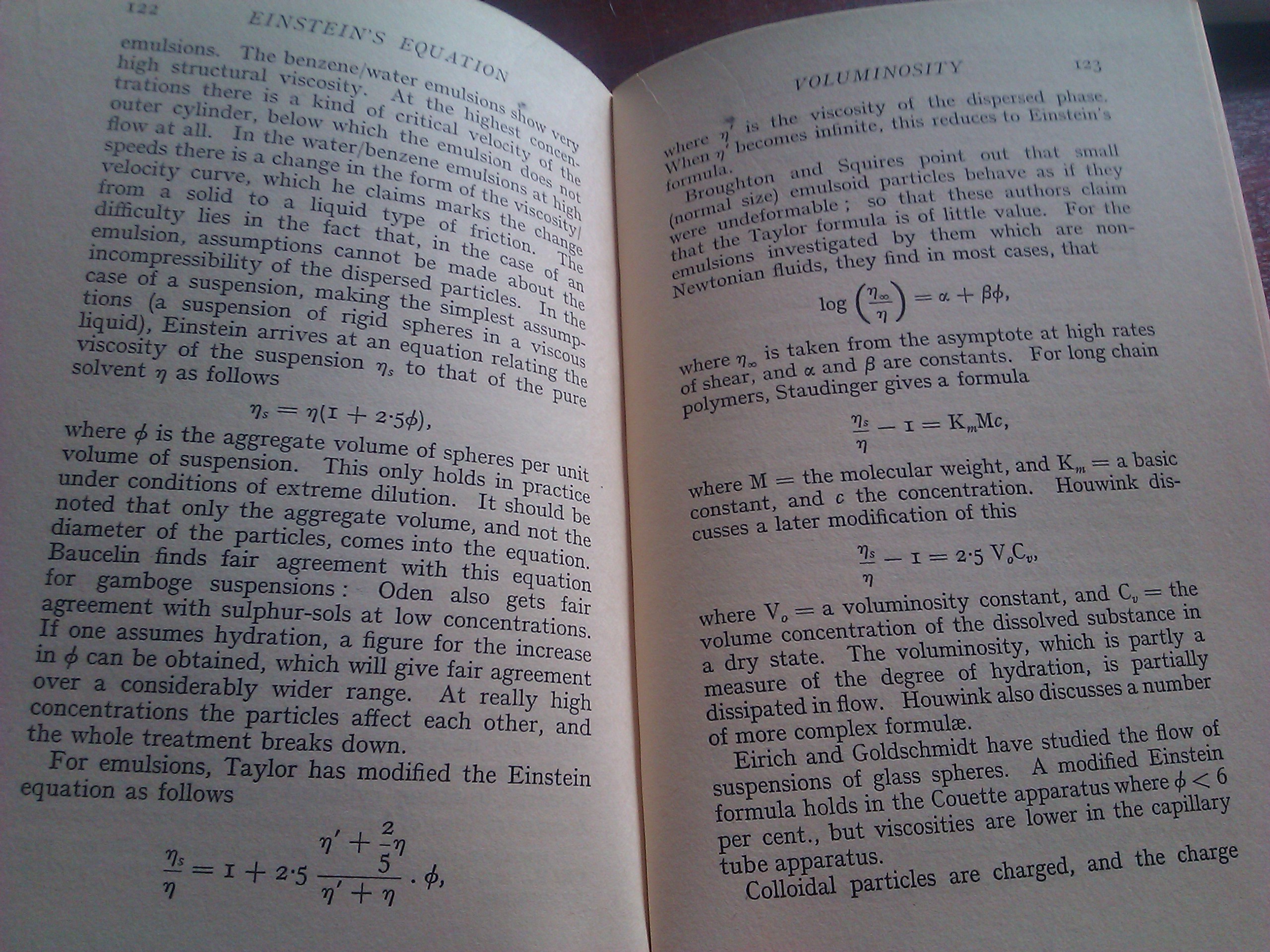str (71)

i

emulsions. The benzc&i^M high structural viscosit trations there is a kina
EQUA TION

outer cylinder, below which the emulsion does the flow at all. In tlie \vater/benzene emulsions at hu speeds there is a change in the form of the yiscosiS yelocity curve, which he claims marks the chanjjl from a solid to a liąuid type of friction. The difficulty lies in the fact that, in the case of an emulsion, assumptions cannot be madę about the incompressibility of the dispersed particles. In the case of a suspension, making the simplest assump-tions (a suspension of rigid spheres in a viscous hquid), Einstein arrives at an eąuation relating the viscosity of the suspension |g to that of the pure solvent g as follows
where <j> is the aggregate volume of spheres per unit vołume of suspension. This only holds in ptactice under conditions of extreme dilution. It should be noted that only the aggregate volume, and not the diameter of the particles, comes into the llpation. Baucelin finds fair agreement with this eąuation for gamboge suspensions: Odeń also gets fair
agreement with sulphur-sols at Iow doncentrations. If one assumes hydration, a figurę for the increase in <f> can be obtained, which will give fait agreement over a considerably wider rangę. At really high concentrations the particles affect each other, and the whole treatment breaks down.
For emulsions, Taylor has modified the Einstein eąuation as follows

9 § the yiscosity of the diapemed plisie, 'iifinmes inlinitc, this reducos to ICmsteins

emulsions investigated by them which are non-Newtonian fluids, they find in most cases, that

where is taken from the asymptote at high rates of shear, and a and § are constants. For long chain polymers, Staudinger gives a formula
I - i = KmMc, V
where M = the molecular weight, and Km = a, basie constant, and c the concentration. Houwink dis-cusses a later modification of this
= 2-5 V„c„,
where V0 = a yoluminosity constant, and C„ = the volume concentration of the dissolved substance in a dry State. The yoluminosity, which is partly a measure of the degree of hydration, is partially dissipated in flow. Houwink also discusses a number of morę complex formulse.
Eirich and Goldschmidt have studied the flow of Suspeńsions of glass spheres. A modińed Einstein formula holds in the Couette apparatus where ^ < 6 per ceni, but viscosities are lower in the capillary tubę apparatus.
Golloidal particles are charged, and the charge
Wyszukiwarka
Podobne podstrony:
199 Vol. 36(2), 2001 polarization of pallial oviduct structures i s difficult, as there is no elear
45213 jff 012 THE MODERN IDEA - JUDO FOR FUN There is no reason for continuing this attitude in Amer
BR01 DELL-10843 The Supremo Space Spectacufar from Univorsal! THERE IS ONE WIAN LEFT IN THE UNIVERSE
Image (21) 3 2 Now choose from sentences A~G the one which fits each gap (1-6). There is one extra s
jak robić kolczyki str 2 2. Add Beads to the top of the earring according to individual beading pa
New?ventures Elementary Teacher s Book testy Unit 8 Test str 2 Write sentences. Use the present per
EUROPEAN UNIONUNION EUROPEENNE This is to certify that The Secretary General of the Council, High
GAMBLING34 FT. HIGH PERFORMANCE FAMILY CRUISER This is a modern 3U tonner designed to the I.O.R.-Rul
6 Contents Katarzyna Kita, Walenty Poczta, Anna Ziemińska: Changes in the level and structure of the
High quality materiał, high definition and elear image, improving your work efficiency. The 37MP hig
Tax expenditures: spending through the Polish tax system 95 comprise the nonnal tax structure and re
WMiMB kolos1 laborki semIII str3 wykresu i zaznaczyć charakterystyczne naprężenia dla materiałów kru
więcej podobnych podstron